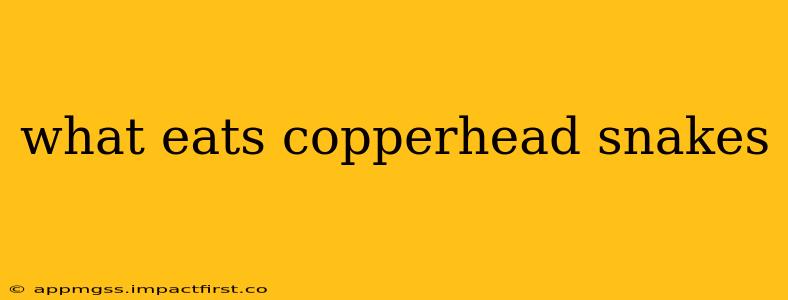Copperhead snakes, while venomous themselves, are not at the top of the food chain. Several predators actively hunt and consume these snakes, playing a vital role in maintaining the balance of their ecosystem. Understanding these predators offers insight into the complexities of the natural world and the interconnectedness of species. This article delves into the animals that prey on copperheads, exploring their hunting methods and the impact on copperhead populations.
What are the main predators of copperhead snakes?
Several animals prey on copperheads, depending on the geographical location and the size of the snake. The most common predators include:
- Hawks: Red-shouldered hawks, red-tailed hawks, and other large raptors are known to hunt copperheads. Their keen eyesight and aerial advantage allow them to spot snakes from above, swooping down to seize them with their talons.
- Larger Snakes: Other snakes, particularly larger species like rat snakes and black snakes, will sometimes prey on copperheads. This often involves a struggle, as the copperhead's venom is a threat.
- Opossums: These marsupials are surprisingly resilient to copperhead venom. Their relatively slow metabolism and thick fur offer some protection, allowing them to successfully hunt and consume copperheads.
- Hognose Snakes: Although smaller than copperheads, hognose snakes are known for their surprising boldness and ability to overcome larger prey through aggressive tactics and constriction.
- Raccoons: While opportunistic feeders, raccoons have been known to prey on smaller copperheads. Their agility and intelligence allow them to overcome the snake's defense mechanisms.
- Wild Pigs: In areas where wild pigs are present, they can pose a significant threat to copperheads. Their powerful jaws and indiscriminate foraging habits mean they may inadvertently consume copperheads.
- Foxes: Both red and gray foxes will sometimes eat copperheads.
What animals are immune to copperhead venom?
No animal is completely immune to copperhead venom. However, some animals have a higher resistance to it than others. The venom's effect depends on factors like the amount injected, the size and health of the prey animal, and the specific venom's potency. Opossums are a notable example of an animal with a relatively high resistance due to their physiology. Even with higher resistance, venom can still cause illness or death in these animals.
Do birds of prey eat copperheads?
Yes, various birds of prey, including hawks and owls, are known to prey on copperheads. Their sharp talons and powerful beaks allow them to capture and kill the snakes, even though copperheads possess venom.
What are the biggest threats to copperhead snakes?
While natural predators are a significant threat, human activity also poses a major risk to copperhead populations. Habitat loss due to deforestation and urbanization is a primary concern. Road mortality, where snakes are killed by vehicles, is also a significant factor. Furthermore, intentional killing of copperheads due to fear or misunderstanding adds to the pressure on their populations.
How do copperheads defend themselves against predators?
Copperheads rely on camouflage to avoid detection by predators. Their mottled coloration helps them blend seamlessly into their surroundings. When detected, they may attempt to flee, but if cornered, they will utilize their venom as a primary defense mechanism. Their strike is swift and accurate, injecting venom that can subdue or kill their attackers.
Understanding the predators of copperhead snakes provides a crucial perspective on the complex dynamics within their ecosystems. While these snakes possess potent venom, they remain an important part of the food web, and their survival depends on a delicate balance between predator and prey. Conservation efforts that focus on protecting their habitat and promoting public education are vital to ensuring their continued presence in the wild.
